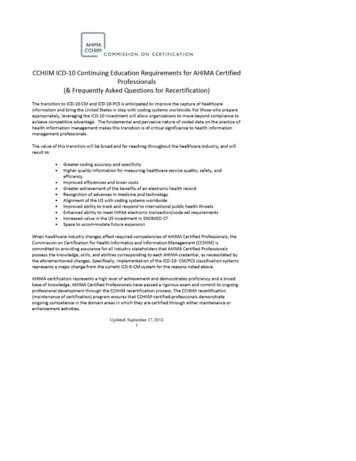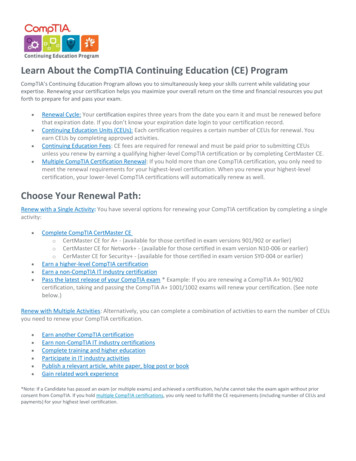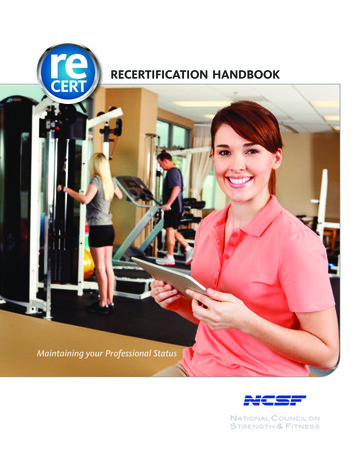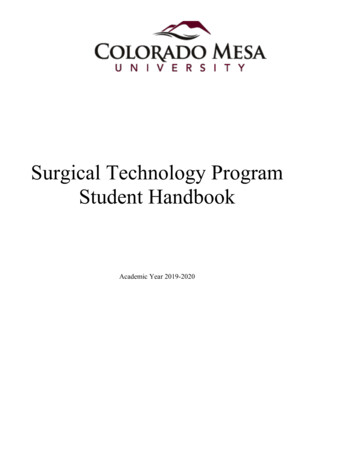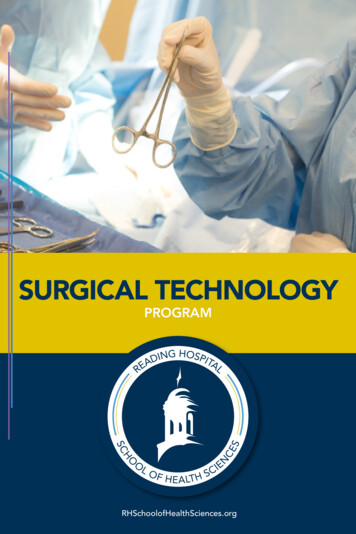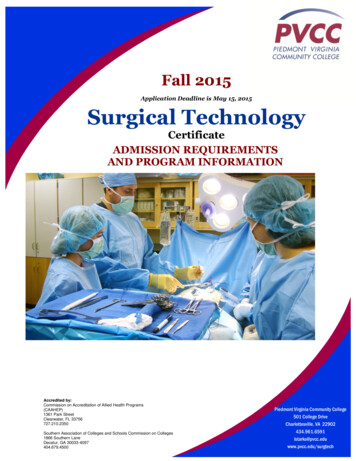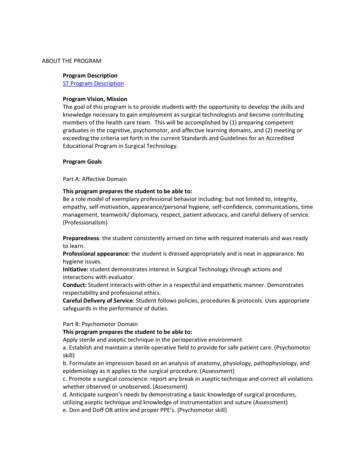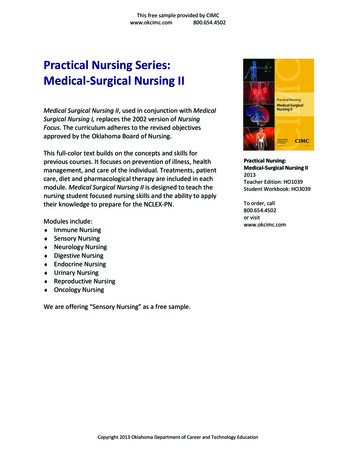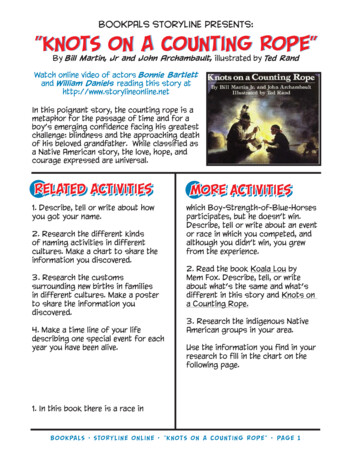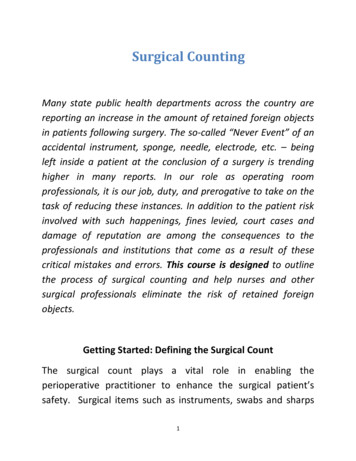
Transcription
Surgical CountingMany state public health departments across the country arereporting an increase in the amount of retained foreign objectsin patients following surgery. The so-called “Never Event” of anaccidental instrument, sponge, needle, electrode, etc. – beingleft inside a patient at the conclusion of a surgery is trendinghigher in many reports. In our role as operating roomprofessionals, it is our job, duty, and prerogative to take on thetask of reducing these instances. In addition to the patient riskinvolved with such happenings, fines levied, court cases anddamage of reputation are among the consequences to theprofessionals and institutions that come as a result of thesecritical mistakes and errors. This course is designed to outlinethe process of surgical counting and help nurses and othersurgical professionals eliminate the risk of retained foreignobjects.Getting Started: Defining the Surgical CountThe surgical count plays a vital role in enabling theperioperative practitioner to enhance the surgical patient’ssafety. Surgical items such as instruments, swabs and sharps1
used by the surgical team to perform invasive procedures, areforeign bodies to the patient and must be accounted for at alltimes to prevent retention and injury to the patient. Manywould argue that surgical counting is the single most importantaspect of the circulating nurses’ duties. Regardless of whetherthis is true or not, surgical counting is undoubtebly one of themost important tasks of the circulating nurse in the operatingroom. In this course, we will discuss counting procedures,items responsible for being counted, methods of accounting forsponges, personnel responsible for performing the counts,recommended time for each count, provide current policy andprocedures for counting, discuss recommended strategies forincorrect count, and many other topics. This course willillustrate just how important the surgical count is to a safeoperating room experience and how vital the circulating nurseis to providing a safe surgical experience.What is a counting procedure?A counting procedure is a method of accounting for items puton the sterile table for use during the surgical procedure.Sponges, sharps, and instruments should be counted and/oraccounted for on all surgical procedures. This includes anymaterials introduced into the patient during the procedure,2
such as rectal or vaginal packs or sterile towels used to pack offor retain viscera.The counting of sponges, needles, sharps, instruments and anyother item that could become lost in a patient are crucial tocount. Items are counted before and after use. The types andnumbers of sponges, needles and other sharps, andinstruments vary for each surgical procedure.The documentation of counts should include the items on theinstrument table at the beginning of the procedure, as well asthose added during the procedure. The count should beperformed audibly and with each sharp visualized by both thescrub person and the perioperative nurse. The number ofneedles should be recorded.During the procedure, the scrub person should be aware of thelocation of sharps on the sterile field. Needles should beaccounted for by the scrub person as they are placed in theneutral zone on a one-for-one exchange basis when possible.Subsequent counts should be performed by the scrub personand perioperative nurse before closure of a body cavity ordeep, large incision, after closure of a body cavity, and at skinclosure. Additional counts should be an element of the handoff process when either the scrub person or the perioperativenurse is permanently relieved by other personnel. In situationswhere personnel may be relieved on a temporary basis, the3
verbal hand-off should include a discussion about counteditems. In all situations, it is imperative that two individuals beinvolved in the count - one counting, and the other witnessingthat the count is correct. All sharps are retained in the ORduring the surgical procedure. Many institutions have printedforms to keep track of routinely counted items. Others useerasable count boards visible to all personnel. Recording thecount is the responsibility of the perioperative nurse.Depending on institutional polcy and practices, the count sheetmay become part of the patient’s record. To facilitate counting,needles are counted according to the number indicated on thepackage; the scrub person verifies this number with theperioperative nurse when the package is opened. Used needlesshould be kept on a needle pad or counter on the scrubperson’s table. Broken or missing needles must be reported tothe surgeon and accounted for in their entirety.Do you know your institutions’ policy for incorrect counts?Each institution should have established policies for dealingwith incorrect counts. Unintentional retention of objectsduring surgery has been identified as a “Never Event”.Institutions are required to adopt a comprehensive strategy tomanage the complexity of this issue. Strategies include severalelements, including: an emphasis of forced communication,4
standard processes, and checklists. In situations where anincorrect count occurs, the surgeon should be immediatelynotified, and a recount should be initiated. Sterile teammembers and the perioperative nurse initiate a search of thesterile and unsterile fields. If the missing item is not revealedafter a recount and search, the surgeon is asked to explore thewound. If the missing item is still not found, agency policy maydictate that an x-ray film be taken. Documentation of theseactivities should be completed according to institutional policyand procedure.Put the “count” in accountabilityAccountability during the surgical count is a professionalresponsibility that rests primarily on both the “scrub person”and the circulating nurse. The surgeon and patient rely on theaccuracy of this accountability by the team. There are severalreasons why it is important for the scrub and circulating nurseto count and be accountable for all items used during theprocedure (Table 1.1).5
Table 1.1Reasons to count - and be accountable - for items used during surgical proceduresIncidentItem can be lost in patient’s bodyItem can be lost in trash or linenItem can be lost from inventory,ResultNeed for additional surgeryPotential harm to other personnelHigh cost of replacementCounts are performed for patient and personnel safety,infection control, and inventory purposes. A needle,instrument, sponge, tape, or towel left in the wound afterclosure is a possible cause for a lawsuit after a surgicalprocedure. Containment and control are also important forinfection control.A retained foreign object made of woven textile is referred toas a gossypiboma or a textiloma. A foreign bodyunintentionally left in a patient can be the source of woundinfection or disruption. The longer the object remains in thebody, the more it incorporates ingrowth of tissue. An abscesscan form, and fistulas may develop between organs. Theforeign body reaction may be immediate or may be delayed foryears. Diagnosis is sometimes difficult and costly, and removalof the object usually requires major surgery. The literaturereports the removal of some retained sponges throughlaparoscopic surgery if they are discovered before adhesionsdevelop. For an example of a foreign body left in a patient, see(Photo 1.1.)6
Photo 1.1A contaminated sponge or needle that is unaccounted for atthe close of procedure could also inadvertently come intocontact with the personnel who clean the room, processinstruments, launder the linens, or transport the trash. Bloodor body fluids are sources of pathogens such as humanimmunodeficiency virus (HIV) or hepatitis B virus (HBV). For7
additional learning on bloodborne pathogens, please see thewww.CuttingEdgeCE.com course on “Humans vs. Superbugs”Inventory control is monitored by accounting for theinstrument set in its entirety. Counting ensures that expensiveinstruments including towel clips and scissors are notaccidentally thrown away or discarded with the drapes. Injuryto laundry and housekeeping/environmental services personnelby the contaminated sharp edges of surgical instruments,blades, and needles is a risk.Adverse effects on patientsBased on an ECRI Institute study (2003) that examinedControlled Risk Insurance Company closed-claims data from1985-2001, patient deaths due to retained surgical objectswere rare. More common adverse outcomes included: Readmission to hospital or prolonged length of stay (59% of cases) Second surgery to remove retained object (69%) Sepsis or infection (nearly 50%) Fistula or small-bowel obstruction (15%) Visceral perforation (7%)One of the patient outcomes identified in the PerioperativeNursing Data (PNDS) is that “the patient is free from signs andsymptoms of injury due to extraneous objects” (Peterson,2007). One of the many perioperative nursing activities8
undertaken to achieve this patient outcome is the performanceof counts to ensure that the patient is free from injuries relatedto retained sponges, sharps, or instruments (Patient Safety).Institutions vary in their policies regarding needle and sharpscounts during operative procedures, but most followestablished procedures based on the Association ofPerioperative Registered Nurses (AORN) RecommendedPractices for Sponge, Sharp and Instrument Counts (AORN,2009b). (See example 1.1).Example 1.1Example of Counting Policy and ProcedureI.OUTCOME STANDARDA. To ensure that the patient is not injured as a result of aretained foreign body.B. To standardize the surgical count process.C. To account for instruments, reusable and disposable.D. To assure this surgical count standard also applies to cases oforgan/tissue procurement.II.POLICYA. Sponges, sharps and miscellaneous items will be counted preoperatively on ALL procedures performed in the operatingroom, establishing a baseline for subsequent counts.9
B. An instrument count is indicated when:a. The surgical wound encompasses a body cavity, such asabdomen, pelvis, or chest.b. All procedures in which there is a possibility that aninstrument/sponge could be retained.c. All procedures in which there is a possibility of progressingto an open procedure or of extending an incision to allow for aninstrument to be left behind. This includes all laparoscopic,thorascopic and pelvioscopic procedures.d. All policies also pertain to pediatric cases.C. Every OR will have an identical, pre-printed count boardmounted on the wall.a. The count boards will reflect the required elements(sponges, sharps, miscellaneous and packed/tucked items. Preprinted items include laps, raytecs, rondics, peanuts, knifeblades, atraumatics, free needles, hypodermic needles, bovietips and bovie scratchers. All other sponge, sharp andmiscellaneous items will be printed onto small magnets thatcan be placed on the board as is appropriate to the procedure.D. At shift change or at time of permanent relief, at least onemember, but preferably both members from the oncomingteam will conduct an accounting of the counted items, with atleast one member of the outgoing team, preferably the scrubperson, for a hand-off/relief count.10
E. The RN circulator and scrub person should not be interruptedduring any part of the counting procedure. If they areinterrupted, they must start the count again in the category ofitems they were counting when interrupted (e.g., lap tapes,mayo clamps, etc.).F. Only X-Ray detectable materials will be used in surgical woundsor body cavities during surgery. (i.e., Kerlix rolls or nonradiopaque towels will not be placed/packed in a body cavityduring a procedure).G. Linen or waste containers will not be removed from the ORuntil all counts are completed, resolved and the patient hasbeen transferred from the operating room.H. A standardized procedure will be used by all staff members torecord the counts on the count boards, this practice must beconsistent from room to room.III. PROCEDUREA. Sponge countsa. Sponges include but are not limited to Raytec (4x4), Laptapes, and Vag tapes, Rondics, Peanuts, Tonsil Sponges andCottonoids. Sponges will be counted in order from largest tosmallest.b. Sponge counts require the full attention of the scrubperson and the RN circulator.11
c. Sponges will be separated, counted audibly andconcurrently viewed together during all counts. Radiopaquetags should be visualized by both parties.d. Sponges will be counted in all procedure where spongesare on the field. The sponge count will be recorded on thecount board.e. The scrub person will observe the number of spongesadded on the count board and acknowledge verbally that thewritten numbers and the total are correct.f. Subsequent sponge counts will be performed:i. When items are added to the fieldii. Before the closure of a cavity within a cavity (e.g., uterus,bladder)iii. Before wound closures begin (closing count; if more thanone wound, closing counts must be done independently forall wounds, if not closed simultaneously).iv. At skin closurev. At the time of permanent relief of the RN circulator or thescrub person; a handoff accounting for the counted itemsmust be done (change/relief count)vi. Upon the request of any team memberg. Any package containing an incorrect number of sponges will beremoved from the OR and not used in the procedure.h. The RN circulator will contain and confine discarded, usedsponges in designated sponge holder bags.12
i.The sponge holder bags must be visible so that all teammembers can view them during the case for the purposes ofblood loss estimation and the verification of counts.ii. Sponges will be placed in the sponge count bags by type,i.e., laps in one, raytex in another, with only 5 lap tapes(one/pocket) or 10 raytex (one/pocket) in each holder.iii. The scrub person will designate a space on the back tableto maintain all small sponges or miscellaneous items forcounting purposes.iv. Final accounting of sponges by surgeon, circulator andscrub will be done during the debriefing. This will be donebefore the patient leaves the OR; at that time, all used andunused sponges should be in the sponge holder bags forverification.i. Non-radiopaque gauze dressing materials should bewithheld from the field until the wound is closed or the caseis completed. Dressing sponges that come in the pack shouldbe left in their plastic zip lock bags and isolated on the backtable away from all other sponges.B. Sharp Counts:a. Sharps include but are not limited to scalpel blades,cautery tips, atraumatic (suture) needles, free needles andhypodermic needles.b. Sharp counts require the full attention of the scrub personand the RN circulator, i.e., the scrub shows the circulator each13
and every sharp item on the field and the circulatordocuments the total numbers on the count board accordingly.c. The scrub person will observe the number of sharps addedon the count board and acknowledge verbally that the writtennumber and total are correct.d. Subsequent sharp counts will be performed:i.When sharps are added to the sterile fieldii.Before the closure of a cavity within a cavity (e.g. bladderor uterus)iii.Before wound closure begins (closing count)iv.At skin closure (final count)v.At the time of permanent relief or change of shift, ahandoff accounting for the counted items must be donevi.Upon the request of any team membervii.Packages of multi-pack needles will be opened, viewedand counted with both scrub person and circulator, duringthe initial count and at the time they are opened until theyare replaced in a sharps container, to avoid inadvertentinjury to a patient or member of the Perioperative team.viii.The scrub person will maintain an accurate account of allsharps on the sterile field frequently comparing the fieldnumbers to those documented on the count board.ix.All counted sharps should remain within the operatingroom and / or sterile field during the procedure.14
x.Sharps that are contaminated or inadvertently fall fromthe field should be retrieved by the circulator, shown tothe scrub person, and isolated from the sterile field. Theyshould not be disposed of in the sharps container until thefinal counts are completed. Sharps that are removed fromthe field should be secured safely on a needle magnet orother appropriate container, so they can be accounted forand visualized during the final counts.xi.Pieces of broken sharps must be accounted for in theirentiretyxii.The scrub person will not discard suture packages during aprocedure; all packages will be saved either on the backtable or in the “sterile” paper trash bag on the field.No packages are to be thrown into the general trash.Matching empty suture packages to rectify a discrepancyin a closing needle count is an acceptable method to verifythe closing/final counts, only if all packages have beensaved. If there is any uncertainty, then a radiograph mustbe taken. The only exception would be if the needle inquestion is known to be 6-0 or smaller, as these may notbe visible on x-ray.C. Count of Miscellaneous Small Items/Devicesa. Miscellaneous small items/devices are generallydisposable items but may be reusable items that could beretained in a wound or body cavity if not counted pre15
operatively and at the time of closing counts. Most of theseitems are not radiopaque.b. Miscellaneous small items/devices include but are notlimited to: Penrose drains, fogarty/novare inserts, bulldogs,irrigation tips/adapters, vessel loops, umbilical tapes, suturebots, tunneller tips/bullets, micro wipes, valvutomes and tips,silastic tubing, safety pins, rubber bands, GYN prep sponges,Capio bullets, Lone Star hooks, fish hooks, eye plugs, visibilitybackground, defogger sponge, hemoclip cartridges, staplerloads, visceral retainers (fish) and laparoscopic sealing caps.c. Miscellaneous items require the full attention of the scrubperson and circulator. The scrub person verbally confirms thenumber and the type of items that the circulatoracknowledges and documents on the count board (labeledmagnets or hand written labels may be used.)d. The scrub person will observe the number formiscellaneous items added on the count board andacknowledge verbally that the written total number is correctfor each item.D. Subsequent counts of miscellaneous items will be performed:a. When items are added to the sterile fieldb. Before the closure of a cavity within a cavity (cavity closurecount)c. Before wound closure begins (closing count: see spongecount re: multiple wounds)16
d. At skin closure (final count)e. At the time of permanent relief or change of shift, a handoff accounting for the counted items must be donef. Upon the request of any team memberE. Instrument Countsa. Instrument counts include all instruments andmiscellaneous pieces associated with that instrument that candetach/come apart (i.e. wing nuts, suction tips, 2 pieces Poolesuctions, balfour pieces, etc.), contained in an instrument trayas well separately wrapped instruments that are added to thesterile field to or during the procedure.b. Instrument counts require the full attention of the scrubperson and the circulator. They will audibly count andconcurrently view together all instruments and verify thequantity listed on the instrument count sheet.c. The practice of counting total number of instruments inthe set is not acceptable.d. Pre-printed instrument count sheets provided in the setfrom central processing will be used to verify the instrumentcounts.e. Instruments added to the sterile field subsequent to theinitial count will be written on the count sheet by thecirculator.f. The instrument count sheets will be kept in a designatedplace in the OR during the case.17
g. All pieces of a broken instrument will be retained in the ORduring the case.h. Subsequent instrument counts will be performed:i.At the time of an addition to the sterile field.ii.Before each wound after a body cavity is closed(closing count)iii.If a closed wound must be re-opened for any reason,a second closing count will be done at a time of secondaryclosure.iv.At the time of permanent relief or change of shift, ahand0off accounting the counted instruments must bedone.v.At the request of any team member.F. Closing instruments counts are not required on laparoscopic,pelvioscopic, thorascopic or mediastinoscopies that do notprogress to “open” procedures, despite an initial count beingdone.a. Circulator will document in that closing instrument countswere not indicated/not applicable because procedure did notproceed to open.G. Instrument Count Sheets:a. The instrument count sheet will be used to record allinstruments and pieces thereof, used in the procedure.Deviations from the instrument count sheet as well as18
instruments added to the field will be documented on thesheets.b. The OR team will complete the instrument count sheet bywriting names of circulator and scrub person, date, OR# andtime. If the instruments match the count sheet, no commentis needed. If there are missing instruments, write the numbermissing (e.g. -2 Kelly clamps). If additional instruments areadded during the case, write those additions in the “add”columns on the count sheet.c. The original count sheets are to remain in the OR with theinstrument sets during the case and returned with theinstrument tray to central processing with any changes noted.H. Special Considerations:a. Any item that is tucked or packed into the wound will beverbally announced by the surgeon and written on the countboard. As items are removed from the wound, they will becrossed off the “packed” items count.b. Initial counts will be done completely on the back table.Counted items should not be brought up to the Mayo orsurgical site until they have been counted.c. The closing and final count sequences will begin at thesurgical site/patient and the immediate surrounding area.Proceed to the Mayo stand, to the back table and finally toitems that have been discarded or removed from the field.19
d. All counts will follow not only a “geographic” sequence butwill follow an “item sequence” as well, following a predetermined order:i.Sponges will be counted from largest (e.g. lap tapes) tosmallest (e.g. peanuts)ii.Next, sharps will be countediii.Third, miscellaneous small items/devices will be countediv.Finally, instruments will be counted. Instrument count willfollow the pre-printed count sheet in terms of order.e. All counted items will remain in the OR for the duration ofthe surgical procedure and will either be discarded orremoved from the OR when the patient leaves the room. (Noextraneous sponges or needle packages should be left in theOR after the patient leaves the room and none should bepresent prior to the next patient arriving.f. The surgeon or scrub person will announce the start of thewound closure.g. The surgeon will conduct an exploratory search of theabdominal and thoracic cavities for counted items beforewound closure begins.h. If counted items are intentionally left in the wound, thetype of item and the number will be recorded on theoperative record/OPTIME.i. Contaminated sponges, sharps, miscellaneous items andinstruments must be handled and disposed of according to the20
Blood borne pathogens standard of the Occupational Safetyand Health Administration (OSHA), facility blood bornepathogen exposure control plan and any other applicableregulations.j. The surgeon will verify the counts with the circulator andthe scrub person before exiting the OR by viewing the spongecount bags to ensure that each pocket of the bag contains asponge. This is part of the debriefing to be done at the end ofthe procedure.k. Special attention to instruments must occur duringorthopedic cases utilizing regular or cannulated drills, drillguides or guide pins. Steps must be taken to ensure theseitems or broken pieces of these items are not implanted in thepatient.i.Orthopedic drills and guide pins will be inspected toensure they are intact and not broken. Inspection willoccur prior to insertion and after removal.ii.Guide pins not intended or approved as an implantwill be removed after use. The cannulated drill/drill guidewill be inspected to verify that nothing remains in theinner channel. All guide pins inserted into the patient willbe verified as totally removed.iii.A verbal verification that the above inspections weredone will occur between the surgeon and the scrub bothduring and at the end of the case.21
iv.Any team member can call for an off count at anytime.l. The OR team will ensure that all pieces of instrumentsrequiring assembly are accounted for prior to the completionof the surgical procedure. Special care will be taken whenthese instruments are used within an orifice or a deep cavityto ensure all pieces are secured.m. Incorrect Countsi.The circulator will notify the attending surgeon andthe anesthesia care provider when an incorrect countoccurs. The appropriate documentation will becompleted per policy.1. The nursing staff will immediately make athorough search of the room, including the floor,linen, trash, kick buckets, case cart shelves and emptyinstrument containers.2. The surgeon will immediately stop closing andexplore the wound for any retained items.3. The scrub person will again search the field andbegin a recount of the missing item.n. If the missing item (sponge/sharp/miscellaneous item orinstrument) is not accounted for, an X-ray of the wound willbe performed in the operating room before the reversal ofanesthesia. The only exceptions to this would be if the22
missing item is a small (6-0 or smaller) needle which is notvisible on x-ray.o. X-rays will be taken for procedures when initial baselinecounts were not obtained (unanticipated open procedures oremergency procedures when there was not time to count.The primary responsibility for accounting for all sponges,sharps, and instruments before, during, and after every surgicalprocedure rests with the circulating nurse and scrub person.Laziness and a cavalier attitude surround the statement, “theincision is too small to lose anything.” Don’t ever be fooled bythis. It can happen. There are several reasons to count and beaccountable for items used in a surgical procedure.1. Patients have been known to retain items from a surgicalprocedure regardless of the size or location of the surgical site.This is a serious safety breach that is not excusable.2. Instruments are costly and should not “vanish into thin air.” Itis a shame that some hospitals x-ray all the trash and havemetal detectors on the doors of the OR. Instruments stuck inwashing machines cause damage to the mechanisms.Accountability significantly decreases this loss.3. Many instruments have sharp tips or cutting surfaces. If aninstrument is in the trash or laundry, it can become a source ofinjury to unsuspecting housekeepers or laundry workers. Thiscan result in prolonged illness and possible inability to work.23
Any item put into the patient should be documented as part ofthe count and reconciled at the end of the procedure. Thesurgeon and first assistant facilitate the count of the items onthe surgical field before closure, however, it is not their job toperform the actual counts. Because accountability for sponges,sharps, and instruments is recognized as essential to safepractice and the Standard of Care, omission of appropriatecounts or a facility’s lack of established procedures for countingand accountability could result in a serious threat of liability.There is no excuse for any retained foreign object if the systemsfor accountability are followed by the entire team.The circulating nurse should document in writing the outcomeof the final counts as correct or incorrect and any unusualincidents concerning them, including the need for a radiographto look for a lost item. If a radiograph is taken, the name of theradiologist and their findings also should be documented. Anincident report should be filed on all counts that remainunresolved. It is not necessary to indicate the actual number ofsponges or needles used on the OR record. The documentationof correct or incorrect counts is sufficient. Any questionablecount should be documented as resolved or unresolved act towhom the event was reported.The initial count will be done when the tray is assembled. Theperson who assembles and wraps items for sterilization will24
count them in standardized multiple units. Some facilitiesenclose a copy of this tray inventory count sheet in theinstrument set. In commercially prepackaged sterile items(e.g., sponges, disposable towels), this count is performed bythe manufacturer.The baseline count will be performed during the setup for thesurgical procedure. The scrub person and the circulating nursetogether count all items before the surgical procedure beginsand during the surgical procedure as each additional package isopened and added to the sterile field. These initial countsprovide the baseline for subsequent counts. Any itemintentionally placed in the wound, such as a towel, is recorded.A useful method for counting is as follows:1. As the scrub person touches each item, he or she and thecirculating nurse number each item aloud until all items arecounted. There is no need to be disruptive when performingthis task. Each pack of sponges will be bound with a paperband that is broken only as each bundle is counted. Thepresence of an intact paper band indicates that bundle has notbeen counted yet. Count them one bundle at a time.2. The circulating nurse immediately records the count for eachtype of item on the count record or wipe-off board. Preprintedforms are helpful for this purpose.25
3. Additional packages should be counted away from counteditems already on the table in case it is necessary to repeat thecount or to discard an item.4. Counting should not be interrupted. The count should berepeated if there is uncertainty because of interruption,fumbling, or any other reason.5. If either the scrub pers
Surgical items such as instruments, swabs and sharps . 2 used by the surgical team to perform invasive procedures, are foreign bodies to the patient and must be accounted for at all times to prevent retention and injury to the patient. Many would argue that surgical counting is the single most important
